English clog dancing, which was hugely popular in the nineteenth and early twentieth century in Australian, has almost completely disappeared from our tradition. However, there are many references and a wealth of collected tunes. A number of dances have survived, notably the Milkmaid’s Waltz, and the Melbourne Clog Dance. Searching through newspapers of the period reveals the popularity of the dance with over 50,000 entries pertaining to clog dancing.
Clogs were commonly the everyday footwear of working people in Great Britain and Australia. Made with a leather upper and a wooden sole, these hard-wearing English clogs were durable, easily re-soled, particularly suited to wet conditions, good for preventing the loss or intrusion of heat, and just as comfortable as shoes. For factory workers and miners in England, the clog was an especially practical choice. In Australia clogs were also considered eminently practical and were widely available, both as imports and from local producers. A clog maker was listed as arriving with the First Fleet, and many advertisements show that clogs were being manufactured throughout Australia up until the early 20th century.
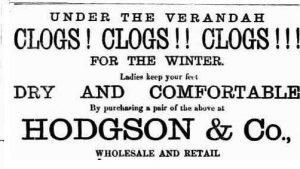
Advertisement for clogs in the Mercury and Weekly Courier , Victoria (1880, October 16). National Library of Australia. http://nla.gov.au/nla.news-article59577552
Dancing in clogs was not new at the beginning of the Industrial Revolution, but it developed as a distinct style with the advent of cotton mills in the North of England. Mill workers mimicked the rhythms of the machinery by tapping the patterns with their feet. Dancing was a well known cure for alleviating boredom and keeping warm, and perhaps the style of dancing on the spot came from mill workers standing at the looms. Miners also adopted the new style of dancing and became keen contestants. People would dance not only in the mills, but in streets and pubs, and many a step was shared on the flagged floors of kitchens.
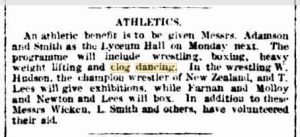
Clog dancing was teamed with wrestling, boxing and heavy weight-lifting. The Age, Melbourne, Vic. (1885, March 25). National Library of Australia. http://nla.gov.au/nla.news-article196952989
A competitive element came into clog dancing where men would challenge each other to dance the most steps while maintaining the clarity of the beats and keeping perfect time. As a working class activity it was associated with such masculine pursuits as wrestling, boxing, heavy weight lifting, as evidenced by an advertisement in the Melbourne Age in 1885. In the world of rural Australia, the clog dance also became an extremely widespread pastime and reports describe step dancing in the pubs wherever workers gathered. Gambling was also involved in many of these competitions which lead to a degree of moral disapproval for the sport.
In 1869, the popularity of clog dancing was manifested in the Great Intercolonial Clog Dancing Competition which attracted 18,000 spectators. Clog dancing championships became especially prevalent in the late 1800s, though the earliest report of a dancing match in Australia dates from 1830, and clog dancing is mentioned in dance competitions as late as the 1970s.

The Great Intercolonial Clog Dance for the Championship of the Southern Hemisphere was held in Melbourne in 1869 and attracted 18,000 spectators.
In 1871, Harry Macklin Shaw of Emmaville in northern New South Wales was awarded a medal for champion clog dancer of Australasia. His story was revealed in the BBC television programme Who Do You Think You Are? which followed the family history of celebrity Craig Revel Horwood.

Harry Macklin Shaw’s medal proclaiming him Clog Dancing Champion of Australasia. Photo courtesy of Peter Shaw
Clog dancing was frequently included in theatre and circus programmes which no doubt encouraged the transmission of new and different steps to all parts of the country. The famous Ashton’s Circus was created by the clog dancer James Ashton with the first performance in Sydney in 1832. Clogs specially made for dancing and performing were available in Australia and these would have been finely crafted in bright colours (red was popular) with designs carved into the leather.
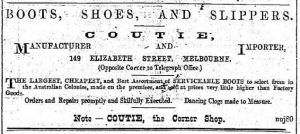
Dancing clogs made to measure at Coutie’s of Melbourne, 1879. National Library of Australia. http://nla.gov.au/nla.news-article70012453
Clogs had always been associated with the working classes and after the First World War the connection with poverty lead to their fall from acceptability and people no longer wanted to wear them. Other forms of dance came to the fore and the clog dance began to be forgotten. Tap dancing, which evolved from the clog dance combined with American and African styles, began to predominate.
Clog dancing today
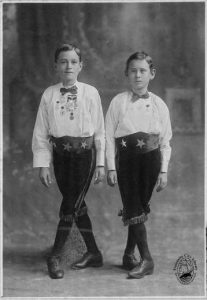
Fred and Hugh Linton danced the Lancashire clog hornpipe in the Fremantle area, WA, 1912. Courtesy of Fremantle History Centre.
Clog dancing in England suffered a similar decline failing to compete with “the glamour of tap-dance, newly imported from America” in the early 20th century, however, after World War II, folk collectors realised the significance of the dance form and began to accumulate dances which still could be found from clog dancers in the North of England. These dances continued to be performed today and a project to introduce the dances into the school curriculum, particular in the north is currently underway. Alex Fisher, one of the leading exponents of the dance form in England writes: “Its strong rhythmic dynamics and physical challenge are compulsive and as a British tradition spanning over 3 centuries, it is, without doubt, one of our nation’s most exciting cultural expressions.”
In Australia, a Clog Waltz (the Milkmaid’s Waltz) was preserved in the repertoire of dance schools, particularly in Highland dancing until the 1970s, however, due largely to the difficulties of acquiring clogs, it seems to have fallen from the syllabus. Fortunately the dance is documented and people still remember it. Margaret Winnett of the Sydney Irish Ceili Dancers has been a prime source of information on this dance.
Please note that the English clog dance traditionally danced in Australia is different to the modern Appalachian clog dance (known as clogging) which now has a following in Australia.
The Melbourne Clog Waltz was preserved in the New Zealand Highland dance repertoire. It is not commonly danced now, but is documented and recorded. This was first noted as being danced in Crookwell, NSW and Geelong, Victoria in 1917. Shirley Andrews, the pioneer of dance collecting in Australia, was given the handwritten instructions for the dance from a dance teacher which seem to date from the 1880s.
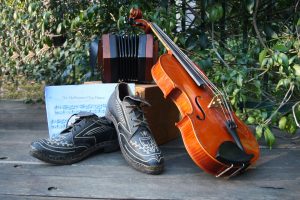
Continuing the tradition of clog dance in Australia: musicians are keen, though dancers are lacking.
Although the clog dancing tradition is largely lost in Australia, fortunately a wealth of tunes have been collected by folklorists and much information can be drawn from these sources. There are a handful of people who know some English clog dances and it would be wonderful to share and appreciate these dances before they are forgotten completely. Over the last few years we have presented a few of the dances at the National Folk Festival in Canberra, notably in conjunction with the Settler’s Session where many of the collected step-dance tunes are played.
Music for Clog Dances.
Listen to “The Melbourne” Clog Dance (mp3)
Download the pdf
Listen to The Sydney Flash (mp3)
Download the pdf
Source: Meredith, J., & Anderson, H. (1968). Folk songs of Australia and the men and women who sang them. Sydney: Ure Smith.
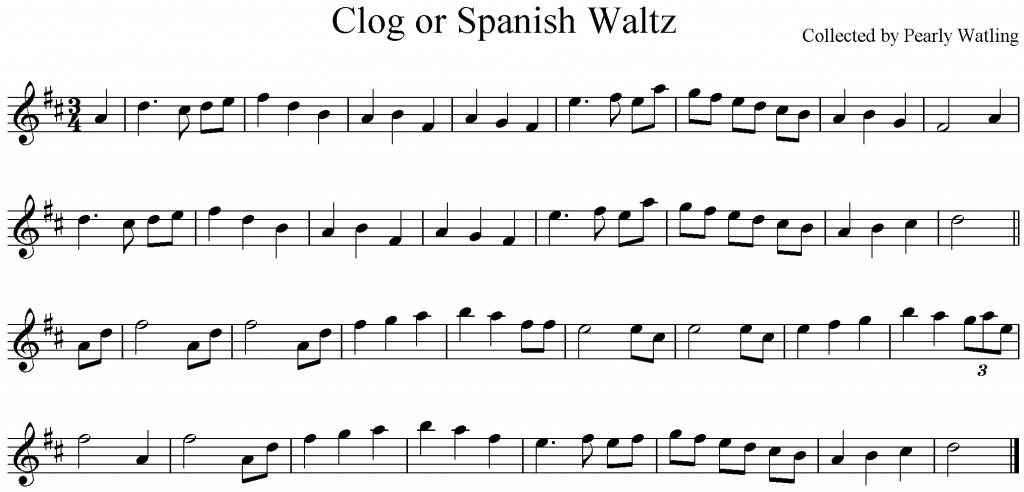 This well-known tune was collected from Pearly Watling of Goulburn. Pearly had learnt the tune from her father, who knew it as the Clog Waltz.
This well-known tune was collected from Pearly Watling of Goulburn. Pearly had learnt the tune from her father, who knew it as the Clog Waltz.
Source: Meredith, J., Covell, R., & Brown, P. (1987). Folk songs of Australia and the men and women who sang them. (Vol. 2). Kensington, N.S.W: Renwick Pride.
We continue research in this area and welcome any information.
See also our pages Trad Steps and Harry Shaw, champion clog dancer.
______________________________________________________________
Sources
Clarke, H. B. (1993). Traditional Step Dancing in Australia. A report compiled with a grant from the Australian Folk Trust.
Fisher, A. (2012). Clog Dance UK. Retrieved from http://www.clogdance.co.uk/index.html
Hornpipe Conference. (1993.). Conference proceedings. The National Early Music Association. (UK). http://chrisbrady.itgo.com/dance/stepdance/hornpipe_conference.htm.
Instep Research Team. Researching traditional step dance in the UK. http://insteprt.co.uk/
Kershaw, C. (1995). Clog Dancing in the Victorian Music Hall. Paper presented at the Border Tensions: Dance and Discourse, University of Surrey.
Meredith, J., & Anderson, H. (1968). Folk songs of Australia and the men and women who sang them. Sydney: Ure Smith.
Meredith, J., Covell, R., & Brown, P. (1987). Folk songs of Australia and the men and women who sang them. (Vol. 2). Kensington, N.S.W: Renwick Pride.
Smith, K. K. A. (2002). The Lancashire Clog Hornpipe Dance on the American Stage, 1840-1940.
The information on this website www.historicaldance.au may be copied for personal use only, and must be acknowledged as from this website. It may not be reproduced for publication without prior permission from Heather Clarke.
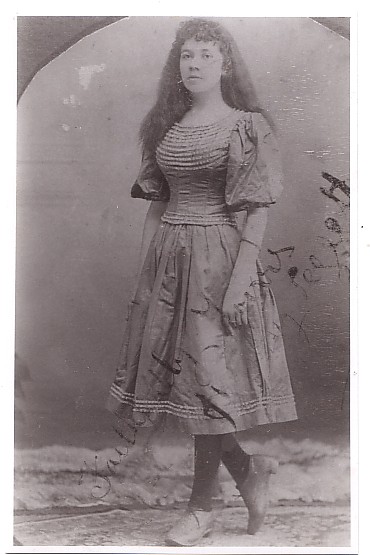
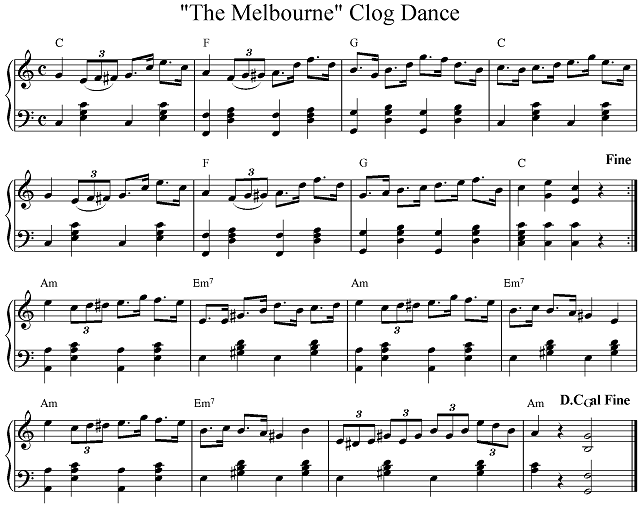
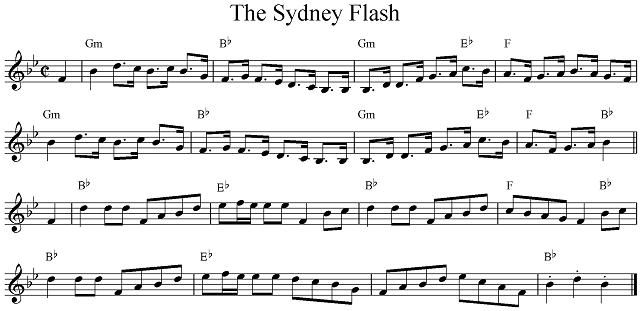


4 Responses to Clog dancing